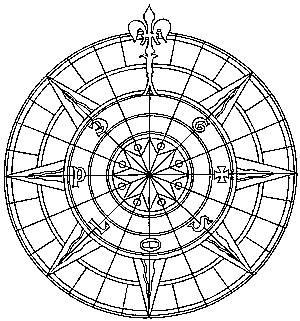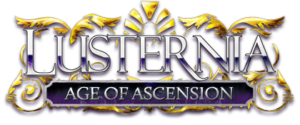Unknown2007-08-28 19:47:45
I have a question concerning a recent bookbinding design. Now, I know that the term "Triachad" is probably an archaic term, but I'm not able to find it on the internet. So I was wondering if anyone knew the modern name of the design found on the face of a sea-navigator's compass? Palladio called it the Triachad and Galileo improved on it when he invented the far-seeing telescope. Here's an image below:

The Triachad portion of the compass is the northwest, northeast, and southern pointing arrows, along with the circle. Compass makers called it the Triachad because it was once thought that the origin of the wind (where it came from) was from the northeast, south, and northwest parts of the world. (It was also thought that the brain worked in the same way; that thought originated from the south part of the brain, the northeast part of the brain, and the northwest part of the brain or the "seat of the three humors").
Here is a picture of a recent compass:

Now, my question, in concerns to design and Lusternia, would be does anyone know the modern name of the compass parts? I know I saw the word Triachad in Moby Dick, but as far as finding it on the internet, I'm coming up empty. Or maybe I'm not thinking of the create spelling of the word or another word all together. I'm a little stumped, to say the least. I need either an equivalent word meaning this particular part of the compass or something else to replace the word "Triachad". Help!
Here's the design below:
Black cloth sits placidly upon the exterior covers of the tome, rich crimson silk bordering the edges in thick, chorded weaves. Several strands of pure silver have been smelted and formed into circles upon the tome's front cover, four larger circles holding a very large ruby at the point where all four circles join. The ruby has been cut into the form of a compass-like star, its nautical reference strengthened by a small golden circle that surrounds the ruby's outer edges. A golden triachad rests on each of the lower and upper edges of the tome, small ruby shards placed at the central point of each one. The author's name and the title of the book rest on the spine of the tome, painted in a crimson red calligraphy that has been accented with a chromatic gold where the letters meet each other. Each interior page boasts a number of small triachad patterns, vaguely printed enough to the point that they are like wisps of grey smoke drifting across the face of the page. A large gold and silver triachad rests on the back of the tome's exterior cover, mirroring the four smaller ones on the front cover. A small black leather flap rests on the top of the tome's spine, acting as a place marker for the reader.

The Triachad portion of the compass is the northwest, northeast, and southern pointing arrows, along with the circle. Compass makers called it the Triachad because it was once thought that the origin of the wind (where it came from) was from the northeast, south, and northwest parts of the world. (It was also thought that the brain worked in the same way; that thought originated from the south part of the brain, the northeast part of the brain, and the northwest part of the brain or the "seat of the three humors").
Here is a picture of a recent compass:

Now, my question, in concerns to design and Lusternia, would be does anyone know the modern name of the compass parts? I know I saw the word Triachad in Moby Dick, but as far as finding it on the internet, I'm coming up empty. Or maybe I'm not thinking of the create spelling of the word or another word all together. I'm a little stumped, to say the least. I need either an equivalent word meaning this particular part of the compass or something else to replace the word "Triachad". Help!
Here's the design below:
Black cloth sits placidly upon the exterior covers of the tome, rich crimson silk bordering the edges in thick, chorded weaves. Several strands of pure silver have been smelted and formed into circles upon the tome's front cover, four larger circles holding a very large ruby at the point where all four circles join. The ruby has been cut into the form of a compass-like star, its nautical reference strengthened by a small golden circle that surrounds the ruby's outer edges. A golden triachad rests on each of the lower and upper edges of the tome, small ruby shards placed at the central point of each one. The author's name and the title of the book rest on the spine of the tome, painted in a crimson red calligraphy that has been accented with a chromatic gold where the letters meet each other. Each interior page boasts a number of small triachad patterns, vaguely printed enough to the point that they are like wisps of grey smoke drifting across the face of the page. A large gold and silver triachad rests on the back of the tome's exterior cover, mirroring the four smaller ones on the front cover. A small black leather flap rests on the top of the tome's spine, acting as a place marker for the reader.
Sthai2007-08-28 20:04:19
I believe another name for it is "compass rose".
Inox2007-08-29 05:55:24
No, that refers to all 8(or 16, 32, whatever) directions. You could use "compass rose" if all else fails, but it does look different.
Xavius2007-08-29 05:58:51
Does anyone else not see anything different about those three arrows? NW, NE, and S look just like E, W, SW, and SE to me.
Xavius2007-08-29 07:11:53
Ok, on further research, I think you need to go look it up again.
Moby Dick is freely available online as full text, which means that the full text is indexed by Google, which means that, when you type "triachad" into Google and get no returns, it ain't in the book.
Further, I found no relationship between the Hindu concept of the humors and any geographic direction. It could not be a Western convention, because the Western tradition has four humors. This seems to further downplay that any reference would be made to it in Moby Dick.
EDIT: And Andrea Palladio was an architect. I have no idea where you're getting any of this. The only three-pointed thing I see on that picture is the fleur-de-lis, which has absolutely nothing to do with humors, seafaring, compasses, architecture, or telescopes.
Moby Dick is freely available online as full text, which means that the full text is indexed by Google, which means that, when you type "triachad" into Google and get no returns, it ain't in the book.
Further, I found no relationship between the Hindu concept of the humors and any geographic direction. It could not be a Western convention, because the Western tradition has four humors. This seems to further downplay that any reference would be made to it in Moby Dick.
EDIT: And Andrea Palladio was an architect. I have no idea where you're getting any of this. The only three-pointed thing I see on that picture is the fleur-de-lis, which has absolutely nothing to do with humors, seafaring, compasses, architecture, or telescopes.
Amarysse2007-08-29 07:37:07
Perhaps these will help.
http://www.gisnet.com/notebook/comprose.html
http://web.uflib.ufl.edu/cm/africana/windrose.htm
It might also help us sort this out if you could explain where you got your information.
http://www.gisnet.com/notebook/comprose.html
http://web.uflib.ufl.edu/cm/africana/windrose.htm
It might also help us sort this out if you could explain where you got your information.

